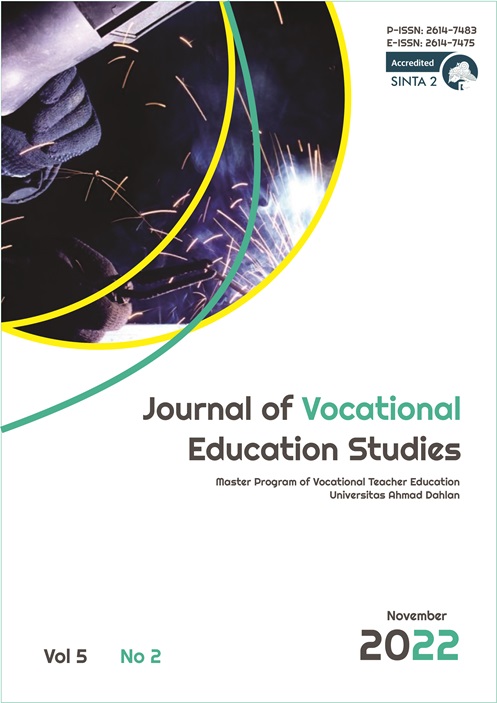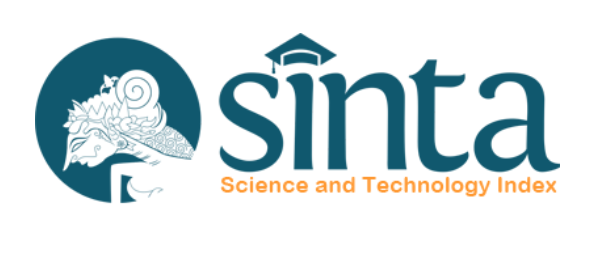Compatibility of the English Needs of Automation and Office Governance Majors Students to The 2013 English Curriculum
DOI:
https://doi.org/10.12928/joves.v5i2.5881Keywords:
English Needs, ESP, Curriculum, Vocational High SchoolAbstract
English teaching in Vocational High School can be taken into account as English for Specific Purposes (ESP) since vocational education aims to prepare students to be a professional in the specific field of work. ESP is designed according to the needs and purposes of the learners in learning the targeted-language. This paper aims to check whether the latest 2013 English curriculum has met the vocational high school students’ needs or not. This study was done in a public vocational high school in Blora regency, Central Java. The data was collected by using observation checklist, questionnaires, and study document. The observation was done to investigate the practice of the 2013 English curriculum in the Automation and Office Governance Major. The questionnaires were given to the students, graduates, and users of graduates to analysis the English needs. Study documents were used to confirm whether the practice and documents prepared by the English teacher is suitable with the curriculum or not.
References
Aliki, K. (2021). Needs Analysis Questionnaire. US-China Education Review B, March-April, 2021, Vol. 11, No. 2, 52-60. https://doi.org/10.17265-6248/2021.02.002
Ashar, A., & Irnawati I. (2016). The Implementation of the 2013 Curriculum of English at SMKN 1 Bantaeng: an Evaluative Study. ELT Worldwide, 3 (2), 156-169. http://dx.doi.org/10.26858/eltww.v3i2.2255
Ayuningtyas, L. P. (2015). English Language Perception and Needs for English for Specific Purpose (ESP) of 11th Grade Students at 116 State High School Ragunan. International Journal of English Language Education, 3 (1), 127. https://doi.org/10.5296/ijele.v3i1.6878
Bariyah, L. et. al. (2014). Analisis Kesesuaian RPP dan Pelaksanaan Pembelajaran Guru SMPN Di Kabupaten Mojokerto pada Sub Materi Fotosintesis dengan Kurikulum 2013. BioEdu, 3(3). Retrieved from http://ejournal.unesa.ac.id/index.php/bioedu/article/view/9558
Belcher, D. (2009). What ESP is and can be: An introduction. English for specific purposes in theory and practice, 1-20. Retrieved from https://www.press.umich.edu/pdf/9780472033843-intro.pdf.
Bhandari, P. (2020). An Introduction to Qualitative Research. Accessed on August 25, 2021. Retrieved from https://www.scribbr.com/methodology/qualitative-research/.
Cowling, J. D. (2007). Needs Analysis: Planning a Syllabus for a Series of Intensive Workplace Courses at a Leading Japanese Company. English for Specific Purposes, Vol. 26, 426 – 442. https://doi.org/10.1016/j.esp.2006.10.003
Creswell, J. W. (2014). Research Design: Qualitative, Quantitative, and Mixed Method Approaches Fourth Edition. California: Sage Publication Inc.
Debata, P. K. (2013). The Importance of Grammar in English Language Teaching: A Reassessment. Language in India, 13(5), 482-486. ISSN 1930-2940. www.languageinindia.com
Ekawati, Y. N. (2016). The Implementation of Curriculum 2013: A Case Study of English Teacher’s Experience at SMA Lab School in Indonesia. ELLd Journal, Vol. 7 (1), 84-90.
Gunawan, H. and Daud, A. (2018). The Implementation of 2013 Curriculum in English Teaching: Stories from Rural Areas. English Language Teaching Educational Journal (ELTEJ), Vol. 1 (2), 65-75.
Gusti, A. (1999). The Role of Needs Analysis in English for Specific Purposes. TEFLIN Journal-A Publication on the Teaching and Learning of English. Vol. 10, No. 1, 31-47. https://doi.org/10.15639/teflinjournal.v10i1/31-47
Hamhij, Naili A., et al. (2014). Analysis of Curriculum 2013 Implemented at Seven Grade of SMP 2 Bandarlampung. UNILA Journal of English Teaching, vol. 3, no. 5.
Hariyadi, A. and Yanti, D. R. (2019). The Importance of Needs Analysis in Materials Development. Jurnal Ilmiah Profesi Pendidikan, Vol. 4 (2), 94-99.
Hidayat, Didin N. (2018). Designing a Lamguage Lesson: Pedagogical and Linguistic Perspectives. Vision: Journal for Language and Foreign Language Learning, Vol. 7 No. 2, 103-112. http://dx.doi.org/10.21580/vjv7i22864.
Hui, G. (2017). The Learning Need analysis of English for Specific Purposes (ESP) in College. US-China Foreign Language, Vol. 15, no. 1, 1-6. https://doi.org/10.17265/1539-8080/2017.01.001
Hutchinson, T. and Waters, A. (1987). English for Specific Purposes: A Learning-Centered Approach. Cambridge: Cambridge University Press.
Kaur, S. (2007). ESP Course Design:Matching Learner Needs to Aims. English for Specific Purposes, Vol. 6, No. 1, 25 – 37.
Krashen, Stephen D. (2009). Principles and Practice in Second Language Acquisition. Introduction to the Internet Edition. Pergamon Press Inc.
Kwartolo, Yuli. (2002). Catatan Kritis tentang Kurikulum Berbasis Kompetensi. Jurnal Pendidikan Penabur, Vol. 1 (1), 106-116. Retrieved from https://www.academia.edu/2389091/Catatan_Kritis_tentang_Kurikulum_Berbasis_Kompetensi
Lapele, F. (2019). Need Analysis on the Material Development of Teaching ESP Speaking. ETERNAL (English Teaching, Learning, and Research Journal), Vol. 5, No. 2, 336-349.
Lestari, I. (2019). Need Analysis of English for Specific Purposes of Vocational School. Bengkulu: Sarjana Thesis, English Education Study Program, Institute Agama Islam Negeri Bengkulu.
Machali, I. (2014). Kebijakan Perubahan Kurikulum 2013 dalam Menyongsong Indonesia Emas Tahun 2045. Jurnal Pendidikan Islam, Vol. 3(1), 71. https://doi.org/10.14421/jpi.2014.31.71-94
Machin, A. (2014). Implementasi Pendekatan Saintifik, Penanaman Karakter dan Konservasi pada Pembelajaran Materi Pertumbuhan. Jurnal Pendidikan IPA Indonesia (Indonesian Journal of Science Education), Vol. 3(1). https://doi.org/10.15294/jpii.v3i1.2898
Mahbub, M. A. (2019). English Teaching in Vocational High School: A need Analysis. JEELS (Journal of English Education and Linguistics Studies), Vol. 5(2), 229-258. https://doi.org/ 10.30762/jeels.v5i2.835
McCombes, S. (2020). How to Do a Case Study. Accessed on August 25, 2021. Retrieved from https://www.scribbr.com/methodology/qualitative-research/.
Nation, I. S. and Macalister, J. (2010). Language Curriculum Design. New York, NY: Routledge.
Peraturan Pemerintah Republik Indonesia Nomor 29 Tahun 1990 tentang Pendidikan Menengah. Accessed on June 10th, 2021. Retrieved from http://www.bphn.go.id/data/documents/90pp029.pdf
Peraturan Menteri Pendidikan dan Kebudayaan Nomor 60 Tahun 2014 tentang Kurikulum SMK. Accessed on June 10th, 2021. Retrieved from https://jdih.kemdikbud.go.id/arsip/Permendikbud_Tahun2014_Nomor60.pdf
Peraturan Menteri Pendidikan dan Kebudayaan Nomor 37 Tahun 2018 tentang Perubahan atas Peraturan Menteri Pendidikan dan Kebudayaan Nomor 24 Tahun 2016 Tentang Kompetensi Inti dan Kompetensi Dasar Pelajaran pada Kurikulum 2013 Pada Pendidikan Dasar dan Pendidikan Menengah. Accessed on June 10th, 2021. Retrieved from https://www.guruberbagi.net/2019/01/permendikbud-37-tahun-2018-tentang-ki.html.
Rahman, M. (2015). English for Specific Purposes (ESP): A Holistic Review. Universal Journal of Education Research, Vol. 3 (1), 24-31. https://doi.org/10.13189/ujer.2015.030104
Sariono, (2013). Kurikulum 2013: Kurikulum Generasi Emas. E-Jurnal Dinas Pendidikan Kota Surabaya, Vol. 3, 1 – 9.
Terrell, Tracy D. (1977). A Natural Approach to Second Language Acquistion and Learning. The Modern Language Journal. http://www.jstor.org/stable/324551.
Thohir, L. (2017). Motivation in a Foreign Language Teaching and Learning. Vision: Journal for Language and Foreign Language Learning, Vol. 6 No. 1, 20-28. http://dx.doi.org/10.21580/vjv6i11580.
Todea, L., & Demarcsek, R. (2016). Needs Analysis for Language course Design. A Case Study or Engineering and Business Students. Innovative Ideas in Science 2016, 1-11. https://doi.org/10.1099/1757-899X/200/1/012064
Tracy, S. J. (2010). Qualitative Quality: Eight “Big-Tent” Criteria for Excellent Qualitative Research. Sage Journals, Vol. 16 (10), 837 – 851.
Undang-Undang Nomor 20 Tahun 2003 tentang Sistem Pendidikan Nasional. Accessed on June 10th, 2021. Retrieved from https://pusdiklat.perpusnas.go.id
Vandermeeren, S. (ed.) (2015). Foreign Language Need of Business Firms. Cambridge: Cambridge University Press.
Widodo, H. P. (2017). Approaches to Need Analysis in ESP Curriculum Development. The European Journal of Applied Linguistics and TEFL, 127-146. Retrieved from https://www.academia.edu/29057102/Approaches_to_Needs_Analysis_in_ESP_Curriculum_Development
Yang, S. (2018). An Analysis on the Individual Needs of English-Major students under the Background of the Reform. Advances in social Science, Education and Humanities Research (ASSEHR), 206, 93-97.
Zurniati, V., & Kustati, M. (2015). Needs Analysis for an English for Specific Purposes (ESP) Subject: A Case Study of State Vocational High School 1 Padang. RiELT Journal, 1 (1), 73-78. Retrieved from http://journal.tarbiyahiainib.ac.id/index.php/rielt/article/view/190
Downloads
Published
Issue
Section
License
Copyright (c) 2022 Universitas Ahmad Dahlan

This work is licensed under a Creative Commons Attribution-ShareAlike 4.0 International License.
Authors who publish with Journal of Vocational Education Studies (JOVES) agree to the following terms: Authors retain the copyright and grant the Universitas Ahmad Dahlan right of first publication with the work simultaneously licensed under a Creative Commons Attribution License (CC BY-SA 4.0) that allows others to share (copy and redistribute the material in any medium or format) and adapt (remix, transform, and build upon the material) the work for any purpose, even commercially with an acknowledgement of the work's authorship and initial publication in Universitas Ahmad Dahlan. Authors are able to enter into separate, additional contractual arrangements for the non-exclusive distribution of the journal's published version of the work (e.g., post it to an institutional repository or publish it in a book), with an acknowledgement of its initial publication in Universitas Ahmad Dahlan. Authors are permitted and encouraged to post their work online (e.g., in institutional repositories or on their website) prior to and during the submission process, as it can lead to productive exchanges, as well as earlier and greater citation of published work (See The Effect of Open Access).










.png)



